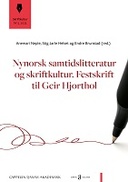Explore

Nynorsk samtidslitteratur og skriftkultur. Festskrift til Geir Hjorthol
0 Ungluers have
Faved this Work
Login to Fave
This issue of Skriftkultur stems from our desire to honor our good colleague Geir Hjorthol with a festschrift on the occasion of his 70th birthday. As the recipient is a professor of literature and also interested in literary culture studies more generally, we have titled the issue Norwegian Nynorsk contemporary literature and written culture.
Geir Hjorthol is himself responsible for the first article, in which he focuses on the role of music within Jon Fosses' novel, Septologien (2019–2022). This article became no less relevant when, a few weeks prior to completion of the issue, Fosse received the Nobel Prize in Literature 2023, the first Norwegian Nynorsk author in the prize’s history.
In the second article, Jan Inge Sørbø questions whether reading literature may be stuck in a critical rut, where one is constantly occupied with revealing something hidden in the text.
The four subsequent articles explore various recent Norwegian Nynorsk novels or authorships. In the first of these, Elin Stengrundet reflects on how Erlend Skjetne's young adult novel Eit anna blikk (2021) connects to modern migration literature and the Norwegian Nynorsk literary tradition, while Nora Simonhjell's article sheds new light on the inner coherence in the authorship of Olaug Nilssen. Marit Brekke and Wenke Mork Rogne present a post-humanistic reading of the Is-slottet (1963) by Tarjei Vesaas, while Beatrice G. Reed examines the precence of nature in Norwegian Nynorsk picture books for children in our time by taking a closer look at 13 prize-winning Norwegian Nynorsk picture books published up until the year 2000.
Non-fiction and the topic of translation are covered by the next two articles. Brage Egil Herlofsen discusses the relationship between Norwegian Nynorsk literary culture and the essay genre, based on two books from the Norsk røyndom-series published by Samlaget (2018), while Marie Nedregotten Sørbø analyzes translations of Jane Austen from English to Norwegian nynorsk in light of literary cultural and hermeneutical perspectives.
In the last article, Stian Hårstad shows how the language culture of our time places emphasis on increased pluralization, not least through the rise of digital technology, which facilitates new forms of interaction via writing, before discussing possible consequences this may have for written culture in general, and for studies of written cultures.
This book is included in DOAB.
Why read this book? Have your say.
You must be logged in to comment.
Rights Information
Are you the author or publisher of this work? If so, you can claim it as yours by registering as an Unglue.it rights holder.Downloads
This work has been downloaded 39 times via unglue.it ebook links.
- 39 - pdf (CC BY) at Unglue.it.
Keywords
- Germanic & Scandinavian languages
- Indo-European languages
- Language qualifiers
- Literature & literary studies
- Literature: history & criticism
- Norwegian
- Scandinavian languages
- thema EDItEUR::2 Language qualifiers::2A Indo-European languages::2AC Germanic and Scandinavian languages::2ACS Scandinavian languages::2ACSN Norwegian
- thema EDItEUR::D Biography, Literature and Literary studies::D Biography, Literature and Literary studies::DS Literature: history and criticism
Links
DOI: 10.23865/noasp.204Editions

